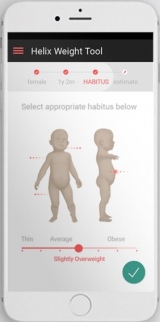

New tool to improve precision of weight estimation could create a safer environment for treating children in the emergency room.
For doctors, knowing the weight of a child during an emergency is a vital piece of information. The accurate estimation of weight is important in order to calculate drug doses, determine the equipment size needed for each child and the energy levels required for defibrillation. Inaccurate and imprecise weight estimation techniques contribute to the high incidence of drug errors in paediatric emergency medicine.
It is often the case that a critically ill child arrives in the Emergency Department resuscitation room with his/her weight unknown to the care team, under conditions where it might not be possible to weigh the child before attending to their care. Examples of when weighing the child is unfeasible include spinal immobilisation, ongoing resuscitation, emergency airway management, or severe pain that means the child is unable to move.
Today nearly a third of children aged 2 to 15 are overweight or obese and younger children are becoming obese at earlier ages and staying obese for longer. With childhood obesity on the rise, old methods used to estimate a child’s weight are not as accurate as they used to be.
 A recent paper by Nicholas Appelbaum, Jonathan Clarke and colleagues at the Helix Centre for Design in Healthcare suggests that a new paediatric weight estimation tool could allow doctors to account for obesity in their weight estimation and allow them to be more accurate with their dosing, tailored for the needs of a specific child.
A recent paper by Nicholas Appelbaum, Jonathan Clarke and colleagues at the Helix Centre for Design in Healthcare suggests that a new paediatric weight estimation tool could allow doctors to account for obesity in their weight estimation and allow them to be more accurate with their dosing, tailored for the needs of a specific child.
By incorporating a subjective assessment of body type and a gender assignment into a simple digital tool capable of an age-in-months based estimation, their work suggests that it is likely to be possible to optimise weight estimation by age, making it at least as safe and accurate as it can be, for the occasions when weight estimation by age is chosen over other methods.
This mobile application needs to be validated in the clinical environment, and the research team look forward to working with interested collaborators in order to do so.
Read the paper here and to find out more about the Helix Centre, visit their website.
Article text (excluding photos or graphics) available under an Attribution-NonCommercial-ShareAlike Creative Commons license.
Photos and graphics subject to third party copyright used with permission or © Imperial College London.
Reporter

Jo Seed
Institute of Global Health Innovation

Contact details
Email: press.office@imperial.ac.uk
Show all stories by this author


